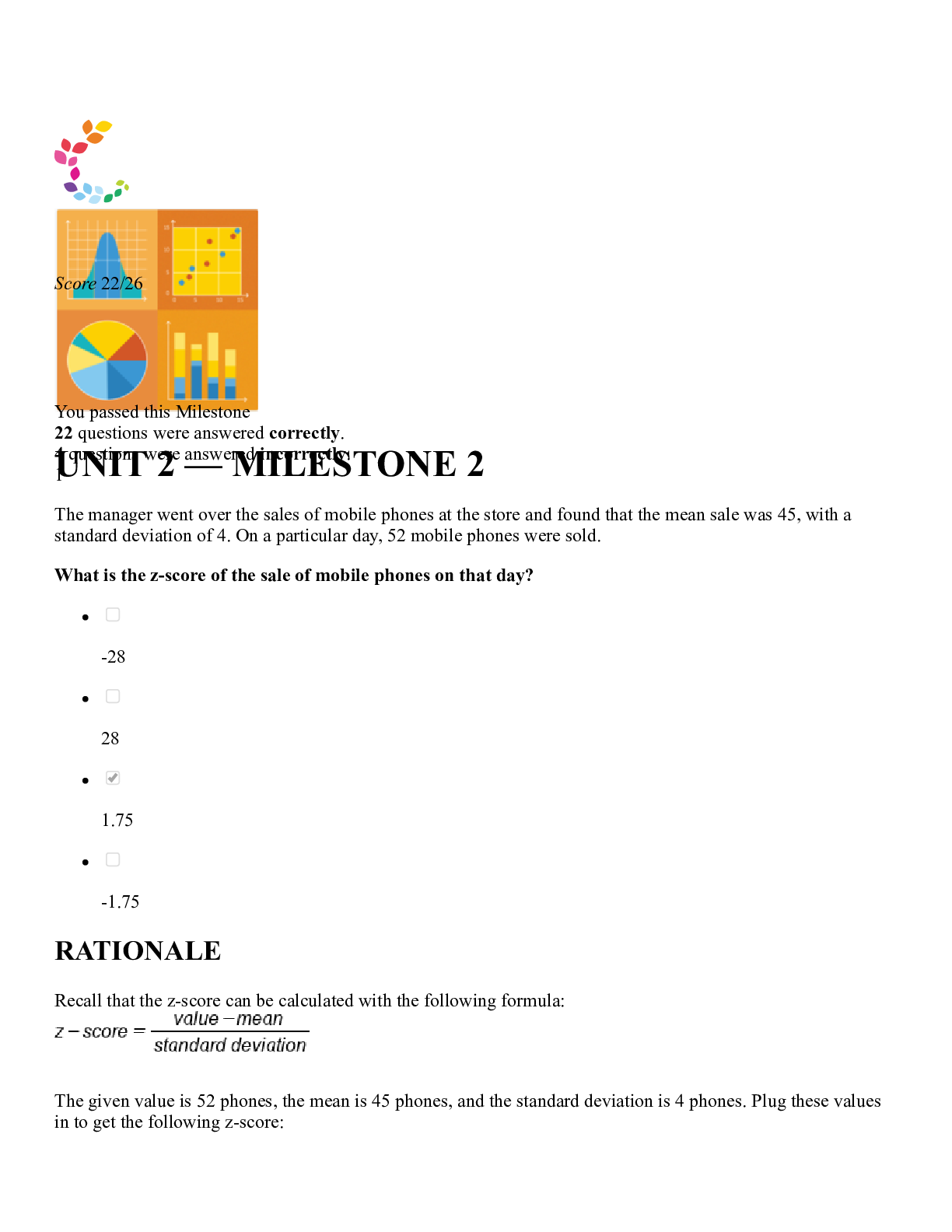
Sophia Statistics Unit 2 Milestone | 22 questions answered correctly
Education > QUESTIONS & ANSWERS > WGU C235 - Final Prep Assessment, Test Questions and answers, 100% Accurate, graded A+ (All)
WGU C235 - Final Prep Assessment, Test Questions and answers, 100% Accurate, graded A+ Aligns human capital with organizational objectives and strategies: a. Company mission statement b. Human ... Resource Management c. Upper-level management d. Training and Development - ✔✔-b. Human Resource Management Tactic knowledge, education, and experience are all examples of: a. Intellectual capital b. Organizational capability c. Human capital d. Social capital - ✔✔-c. Human capital Sustainable competitive advantage is built upon: a. Organizational commitment b. Intangible resources c. Business strategy d. Training and development - ✔✔-d. Training and development According to the stages of HR Competency, developing credibility and a reputation are both part of what stage? Influencing Mastering Applying Acquiring - ✔✔-Applying Which of the following is the responsibility of line management and not the human resources department? a. Coordinates career planning and employee development efforts b. Prepares knowledge and skill training materials c. Provides feedback on the effectiveness of formal training efforts d. Provides input and expertise for individual and organizational development efforts - ✔✔-c. Provides feedback on the effectiveness of formal training efforts The goal of needs assessment is to: I: Determine whether a training need exists II: Who it is that needs the training III: Where in the organization the need exists IV: Exactly what kind of training is needed a. I, III, and IV b. I, II, and IV c. I, II, and III d. I, II, III, and IV - ✔✔-a. I, III, and IV What are the three levels of needs assessment? a. Behavior, organizational, and analysis b. Analysis, implementation, and feedback c. Organizational, task, and person d. Task, behavior, and feedback - ✔✔-c. Organizational, task, and person A learning objective should be a/an ________ objective. Performance Behavior Obtainable Skill - ✔✔-Behavior What can be the most powerful kind of feedback for learning? Positive Reflection Observation Negative - ✔✔-Observation Concrete experience, reflective observation, abstract conceptualization, and active experimentation are all examples of: a. Learning approaches b. Learner characteristics c. Learning styles d. Learner categories - ✔✔-a. Learning approaches In order to be ready for training, trainees need high self-efficacy. In other words, trainees need: a. The motivation and determination to make the training beneficial b. Personal ambitions and goals c. To feel they are of worth to the company d. To believe they are capable of learning the material - ✔✔-d. To believe they are capable of learning the material Training and development methods can be divided into three categories: a. Simulation, behavior, and information presentation b. Information presentation, skills, and technical c. Behavior, skills, and technical d. Information presentation, simulation, and on-the-job - ✔✔-d. Information presentation, simulation, and on-the-job Sensitivity training is an example of: a. Information presentation training b. Simulation training c. On-the-job training d. All of the above - ✔✔-b. Simulation training What is currently the most common approach to training? a. E-learning b. External learning c. Classroom learning d. Blended learning - ✔✔-c. Classroom learning A variation of e-learning: a. Self study b. Case studies c. Blended learning d. Virtual classroom learning - ✔✔-c. Blended learning During which step of the on-the-job training process do you make sure trainees know each point of the training? a. Perform follow-up b. Prepare the learners c. Present the information d. Have trainee practice - ✔✔-c. Present the information Is able to relate practical experiences, and conduct problem solving exercises: a. Communication expert b. Consultant c. Training expert d. Subject matter expert - ✔✔-d. Subject matter expert Learning in training that does not affect performance on the job is called: Negative transfer Wasted training Zero transfer Unsuccessful training - ✔✔-Zero transfer What are the two types of positive transfer? Future and current Near and far Established and successful Actual and perceived - ✔✔-Near and far Traits, ability, and motivation are all considered: Training design Trainee characteristics Work environment Trainer characteristics - ✔✔-Trainee characteristics The opportunity for practice consists of all the following dimension EXCEPT: Task type Activity level Job relevance Breadth - ✔✔-Job relevance Which of the following is NOT a level of criteria in training evaluation? Behavior Learning Application Reaction - ✔✔-Applicatio [Show More]
Last updated: 2 years ago
Preview 1 out of 17 pages

Buy this document to get the full access instantly
Instant Download Access after purchase
Buy NowInstant download
We Accept:


C235 Pre-assessment, Test Questions and answers, 100% Accurate, graded A+
By Topmark 2 years ago
$35
28
Can't find what you want? Try our AI powered Search
Connected school, study & course
About the document
Uploaded On
Mar 14, 2023
Number of pages
17
Written in
All
This document has been written for:
Uploaded
Mar 14, 2023
Downloads
0
Views
141
Scholarfriends.com Online Platform by Browsegrades Inc. 651N South Broad St, Middletown DE. United States.
We're available through e-mail, Twitter, Facebook, and live chat.
FAQ
Questions? Leave a message!
Copyright © Scholarfriends · High quality services·